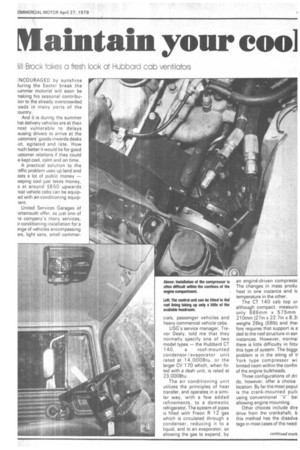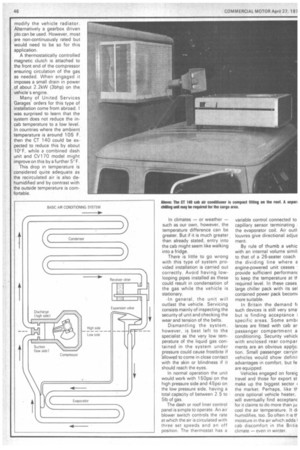Maintain your cool
Page 47

Page 48

If you've noticed an error in this article please click here to report it so we can fix it.
iII Brock takes a fresh look at Hubbard cab ventilators
:NCOURAGED by sunshine luring the Easter break the iummer motorist will soon be naking his seasonal contribuion to the already overcrowded oads in many parts of the :ountry.
And it is during the summer hat delivery vehicles are at their nost vulnerable to delays ausing drivers to arrive at the ustomers' goods inwards desks pot, agitated and late. How nuch better it would be for good ustomer relations if they could e kept cool, calm and on time.
A practical solution to the 'affic problem uses up land and osts a lot of public money — eeping cool just takes money, s at around £650 upwards lost vehicle cabs can be equiped with air-conditioning equiplent.
United Services Garages of 'ortsmouth offer, as just one of le company's many services, ir conditioning installation for a )nge of vehicles encompassing 3rs, light vans, small commer
cials, passenger vehicles and heavy commercial vehicle cabs.
USG's service manager, Trevor Dealy, told me that they normally specify one of two model types — the Hubbard CT 140, a roof-mounted condensor / evaporator unit rated at 14,000Btu, or the larger CV 170 which, when fitted with a dash unit, is rated at 23,000Btu.
The air conditioning unit utilizes the principles of heat transfer, and operates in a similar way, with a few added refinements, to a domestic refrigerator. The system of pipes is filled with Freon R 12 gas which is circulated through a condenser, reducing it to a liquid, and to an evaporator, so allowing the gas to expand, by an engin6-driven compress( The changes in mass produ heat in one instanCe and lc temperature in the other.
The CT 140 cab top ur although compact, measurii only 686mm x 575mrn 210mm (271n x 22.7in x 8.3i weighs 26kg (581b) and thei fore requires that support is a cled to the roof structure in son instances. However, normal there is little difficulty in fittii this type of system. The biggE problem is in the siting of tl York type compressor wi limited room within the confin of the engine bulkheads.
Three configurations of dti do, however, offer a choice location. By far the most popul is the crank-mounted pull' using conventional "V' be allowing engine mounting.
Other choices include dire drive from the crankshaft, b this method has the disadva tage in most cases of the need modify the vehicle radiator. Alternatively a gearbox driven pto can be used. However, most are non-continuously rated but would need to be so for this application.
A thermostatically controlled magnetic clutch is attached to the front end of the compressor ensuring circulation of the gas as needed_ When engaged it imposes a small drain in power of about 2.2kW (3bhp) on the vehicle's engine.
Many of United Services Garages' orders for this type of installation come from abroad. I was surprised to learn that the system does not reduce the incab temperature to a low level. In countries where the ambient temperature is around 105 F. then the CT 140 could be expected to reduce this by about 10cF, while a combined dash unit and CV170 model might improve on this by a further 5 F.
This drop in temperature is considered quite adequate as the recirculated air is also dehumidified and by contrast with the outside temperature is comfortable. In climates — or weather — such as our own, however, the temperature difference can be greater. But if it is much greater than already stated, entry into the cab might seem like walking into a fridge.
There is little to go wrong with this type of system pro
vided installation is carried out
correctly. Avoid having lowlooping pipes installed as these could result in condensation of the gas while the vehicle is stationary.
In general, the unit will outlast the vehicle. Servicing consists mainly of inspecting the security of unit and checking the wear and tension of the belts.
Dismantling the system. however, is best left to the specialist as the very low tem perature of the liquid gas contained in the system under pressure could cause frostbite if allowed to come in close contact with the skin or blindness if it should reach the eyes.
In normal operation the unit would work with 150psi on the high pressure side and 45psi on the low pressure side, having a total capacity of between 2.5 to 51b of gas.
The dash or roof liner control panel is simple to operate. An air blower switch controls the rate at which the air is circulated with three set speeds and an off position. The thermostat has a variable control connected to capillary sensor terminating ; the evaporator coil. Air outll louvres give directional adjus. ment.
By rule of thumb a vehic with an internal volume simi[ to that of a 26-seater coach the dividing line where a engine-powered unit ceases • provide sufficient performanc to keep the temperature at tf required level. In these cases large chiller pack with its sel contained power pack becomi more suitable.
In Britain the demand ft such devices is still very sma but is finding acceptance specific areas. Some ambi lances are fitted with cab an passenger compartment a conditioning. Security vehicIE with enclosed rear compar ments are an obvious appljp tion. Small passenger carryir vehicles would show defini• advantages in comfort, but fe are equipped.
Vehicles engaged on foreig travel and those for export st make up the biggest sector ■ the market. Perhaps, like th once optional vehicle heater, will eventually find acceptanc for it claims to do more than ju cool the air temperature. It di humidifies, too. So often it is ttmoisture in the air which adds I cab discomfort in the Brit's climate — even in winter.
















































































































































